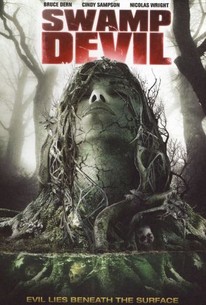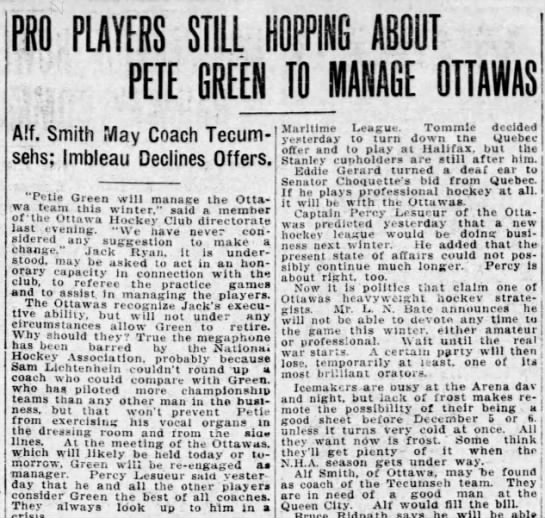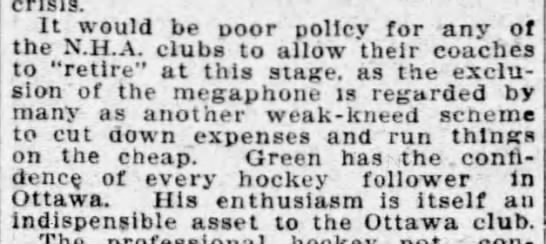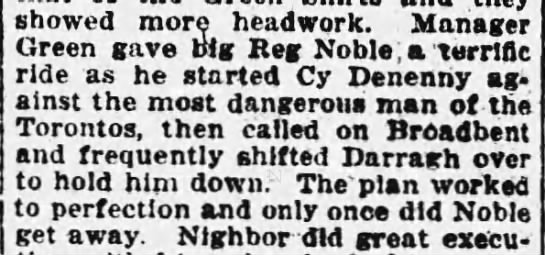ResilientBeast
Proud Member of the TTSAOA
NJ Swamp Devils (1)

Coach: Ken Hitchcock
Assistant/PP Coach: Bob Johnson
Vladimir Krutov - Sid Abel (C) - Guy Lafleur
Boris Mayorov (A) - Vyacheslav Starshinov - Bobby Bauer
Tony Leswick - Cooney Weiland - Mush March
Ab McDonald - Mike Ricci - Tim Kerr
Allan Stanley - Earl Seibert (A)
Vladimir Lutchenko - Flash Hollett
Vasili Pervukhin - Doug Young
George Hainsworth
Ben Bishop
PP1:
Tim Kerr
- Vladimir Krutov - Sid Abel - Guy Lafleur
Flash Hollett
PP2:
Boris Mayorov - Vyacheslav Starshinov - Bobby Bauer
Allan Stanley - Earl Seibert
PK1: Cooney Weiland - Tony Leswick - Allan Stanley - Earl Seibert
PK2: Viachelsav Starshinov - Mush Marsh - Vladimir Lutchenko - Doug Young
PK3: Vladimir Krutov - Sid Abel
Spares: Jack Evans (D), Steve Sullivan (F)
Estimated Ice Time
[TBODY]
[/TBODY]
[TBODY]
[/TBODY]
VS
Coach: Ken Hitchcock
Assistant/PP Coach: Bob Johnson
Vladimir Krutov - Sid Abel (C) - Guy Lafleur
Boris Mayorov (A) - Vyacheslav Starshinov - Bobby Bauer
Tony Leswick - Cooney Weiland - Mush March
Ab McDonald - Mike Ricci - Tim Kerr
Allan Stanley - Earl Seibert (A)
Vladimir Lutchenko - Flash Hollett
Vasili Pervukhin - Doug Young
George Hainsworth
Ben Bishop
PP1:
Tim Kerr
- Vladimir Krutov - Sid Abel - Guy Lafleur
Flash Hollett
PP2:
Boris Mayorov - Vyacheslav Starshinov - Bobby Bauer
Allan Stanley - Earl Seibert
PK1: Cooney Weiland - Tony Leswick - Allan Stanley - Earl Seibert
PK2: Viachelsav Starshinov - Mush Marsh - Vladimir Lutchenko - Doug Young
PK3: Vladimir Krutov - Sid Abel
Spares: Jack Evans (D), Steve Sullivan (F)
Estimated Ice Time
| Forwards | ||||
| Name | ES | PP | PK | Total |
| Vladimir Krutov | 14 | 4 | 1 | 19 |
| Sid Abel | 14 | 4 | 1 | 19 |
| Guy Lafleur | 16 | 4* | 20 | |
| Boris Mayorov | 13 | 3 | 16 | |
| Vladimir Starshinov | 13 | 3 | 2 | 18 |
| Bobby Baeur | 13 | 3 | 16 | |
| Tony Leswick | 13 | 4 | 17 | |
| Conney Weiland | 13 | 4 | 17 | |
| Mush March | 13 | 2 | 15 | |
| Ab McDonald | 6 | 6 | ||
| Mike Ricci | 6 | 6 | ||
| Tim Kerr | 4 | 4 | 8 | |
| Total | 138 | 26* | 14 |
| Defensemen | ES | PP | PK | Total |
| Allan Stanley | 16 | 2 | 4 | 22 |
| Earl Seibert | 18 | 2 | 4 | 24 |
| Vladimir Lutchenko | 16 | 2 | 18 | |
| Flash Hollett | 14 | 5 | 19 | |
| Vasili Pervukhin | 13 | 1 | 1 | 15 |
| Doug Young | 13 | 3 | 16 | |
| Total | 92 | 9 | 14 |
VS
Pittsburgh AC (3)
Original Red and White colours of the AC


Head Coach:
Pete Green
Assistant Coach:
Larry Robinson
Forwards:
Bert Olmstead - Jean Beliveau (C) - Helmuts Balderis
Smokey Harris - Russell Bowie - Blair Russell
Bob Gainey (A) - Doug Jarvis - Ed Westfall
Chris Kunitz - Harry "Rat" Westwick - Cully Wilson
Spare:
Jason Arnott
Defensemen:
Duncan Keith - Art Coulter (A)
Hamby Shore - Fred Lake
Eduard Ivanov - Dan Girardi
Spare:
Brooks Orpik
Goalies:
Georges Vezina
Corey Crawford
Special Teams:
PP 1:
Bowie - RHS (trigger/half wall into slot) Beliveau - LHS (net front) - Olmstead - LHS (cornerman/facilitator)
Ivanov - RHS (trigger) - Shore- LHS (QB)
PP 2:
Westwick - RHS (half wall) - Harris - LHS (net front/slot) - Balderis - LHS (float)
Ivanov - RHS (trigger) - Keith - LHS (QB)
PK 1:
Jarvis - Westfall
Lake - Coulter
PK 2:
Gainey - Russell
*Keith/Orpik - Girardi
*When playing with 7 Dmen on away ice Orpik will take Keith's spot on the 2nd unit. This frees up Keith to play even more time @ ES which I want out of my #1.
Line Combinations Home/Away:
STANDARD LINE UP @ HOME:
Olmstead - Beliveau - Balderis
Harris - Bowie - Russell
Gainey - Jarvis - Westfall
Kunitz - Westwick - Wilson
Keith - Coulter
Shore - Lake
Ivanov - Girardi
BALANCED LINE UP @ HOME
Olmstead - Beliveau - Westfall
Gainey - Bowie - Russell
Harris - Jarvis - Balderis
Kunitz - Westwick - Wilson
Keith - Coulter
Shore - Lake
Ivanov - Girardi
*Really like this fit as a change of pace given it spreads the offensive talent around the top 9 more than consolidating it on the scoring lines. Green can role this out to keep teams off balance. Balderis can carry a line offensively here while Jarvis can play a Larionov role between 2 wingers who are much more offensively gifted than the Gainey/Westfall. Beliveau and Bowie have elite checkers who can do heavy lifting in the corners and defensive zone while retaining the ability to get the puck to the C.
PROTECTING LEAD LATE @ HOME:
Olmstead - Beliveau - Balderis
Kunitz - Bowie - Wilson
Gainey - Jarvis - Westfall
Harris - Westwick - Russell
Keith - Coulter
Shore - Lake
Ivanov - Girardi
*Lines 3 and 4 will see increased action, with neutral ice clogged up. Force teams to dump and then use the speed and transition ability of our top 4 D to recover puck and move in counter direction.
WHEN TRAILING LATE @ HOME:
Olmstead - Beliveau - Balderis
Harris - Bowie - Wilson
Kunitz - Westwick - Westfall
Gainey - Jarvis - Russell
Keith - Coulter
Shore - Lake
Ivanov - Girardi
*Not a big change from standard lineup. Just inserting a bit more offense into top 9 with Kunitz and Wilson and rolling 3 lines late if trailing.
STANDARD LINE UP @ AWAY : (11 F - 7 D)
Olmsted - Beliveau - Balderis
Harris* - Bowie - Russell*
Gainey* - Jarvis - Westfall*
Westwick - Wilson
Keith - Coulter
Shore - Lake
Ivanov - Girardi
Oprik (PK specialist)
* Will all take extra shifts to cover 4LW vacancy.
This lineup is to maximize Keith's ES time. I want the #1 out @ ES as much as possible. He's already in the upper echelons of Dmen in terms of logging minutes but having Orpik means Keith only sees time on the 2nd PP unit.
The rest of the lineup can be juggled as outlined above w/ the home variations.
Original Red and White colours of the AC
Head Coach:
Pete Green
Assistant Coach:
Larry Robinson
Forwards:
Bert Olmstead - Jean Beliveau (C) - Helmuts Balderis
Smokey Harris - Russell Bowie - Blair Russell
Bob Gainey (A) - Doug Jarvis - Ed Westfall
Chris Kunitz - Harry "Rat" Westwick - Cully Wilson
Spare:
Jason Arnott
Defensemen:
Duncan Keith - Art Coulter (A)
Hamby Shore - Fred Lake
Eduard Ivanov - Dan Girardi
Spare:
Brooks Orpik
Goalies:
Georges Vezina
Corey Crawford
Special Teams:
PP 1:
Bowie - RHS (trigger/half wall into slot) Beliveau - LHS (net front) - Olmstead - LHS (cornerman/facilitator)
Ivanov - RHS (trigger) - Shore- LHS (QB)
PP 2:
Westwick - RHS (half wall) - Harris - LHS (net front/slot) - Balderis - LHS (float)
Ivanov - RHS (trigger) - Keith - LHS (QB)
PK 1:
Jarvis - Westfall
Lake - Coulter
PK 2:
Gainey - Russell
*Keith/Orpik - Girardi
*When playing with 7 Dmen on away ice Orpik will take Keith's spot on the 2nd unit. This frees up Keith to play even more time @ ES which I want out of my #1.
Line Combinations Home/Away:
STANDARD LINE UP @ HOME:
Olmstead - Beliveau - Balderis
Harris - Bowie - Russell
Gainey - Jarvis - Westfall
Kunitz - Westwick - Wilson
Keith - Coulter
Shore - Lake
Ivanov - Girardi
BALANCED LINE UP @ HOME
Olmstead - Beliveau - Westfall
Gainey - Bowie - Russell
Harris - Jarvis - Balderis
Kunitz - Westwick - Wilson
Keith - Coulter
Shore - Lake
Ivanov - Girardi
*Really like this fit as a change of pace given it spreads the offensive talent around the top 9 more than consolidating it on the scoring lines. Green can role this out to keep teams off balance. Balderis can carry a line offensively here while Jarvis can play a Larionov role between 2 wingers who are much more offensively gifted than the Gainey/Westfall. Beliveau and Bowie have elite checkers who can do heavy lifting in the corners and defensive zone while retaining the ability to get the puck to the C.
PROTECTING LEAD LATE @ HOME:
Olmstead - Beliveau - Balderis
Kunitz - Bowie - Wilson
Gainey - Jarvis - Westfall
Harris - Westwick - Russell
Keith - Coulter
Shore - Lake
Ivanov - Girardi
*Lines 3 and 4 will see increased action, with neutral ice clogged up. Force teams to dump and then use the speed and transition ability of our top 4 D to recover puck and move in counter direction.
WHEN TRAILING LATE @ HOME:
Olmstead - Beliveau - Balderis
Harris - Bowie - Wilson
Kunitz - Westwick - Westfall
Gainey - Jarvis - Russell
Keith - Coulter
Shore - Lake
Ivanov - Girardi
*Not a big change from standard lineup. Just inserting a bit more offense into top 9 with Kunitz and Wilson and rolling 3 lines late if trailing.
STANDARD LINE UP @ AWAY : (11 F - 7 D)
Olmsted - Beliveau - Balderis
Harris* - Bowie - Russell*
Gainey* - Jarvis - Westfall*
Westwick - Wilson
Keith - Coulter
Shore - Lake
Ivanov - Girardi
Oprik (PK specialist)
* Will all take extra shifts to cover 4LW vacancy.
This lineup is to maximize Keith's ES time. I want the #1 out @ ES as much as possible. He's already in the upper echelons of Dmen in terms of logging minutes but having Orpik means Keith only sees time on the 2nd PP unit.
The rest of the lineup can be juggled as outlined above w/ the home variations.





